David Dwight Eisenhower (October 14, 1890 – March 28, 1969) — he was later to transpose the first two names — was born in Denison, Texas, the third of seven sons born to parents of German-Swiss Protestant descent. At the age of 2, his family moved to Abilene, Kansas, where his father worked as a mechanic in a creamery. He was keen to have a military career and was admitted to the US Military Academy at West Point. He was also a keen football player, but a knee injury put paid to his playing days. His first military posting was to Fort Sam Houston in Texas, where he met and married Mamie Doud. During the First World War he trained tank battalions in the USA and from 1922 to 1924 was stationed in the Panama Canal. He impressed his superiors and was sent to the Command and General Staff School at Fort Leavenworth, Kansas, graduating first in a class of 275. In 1933 he was appointed as an aide to General Douglas MacArthur. In 1941 he demonstrated a remarkable capacity for co-ordination in battle manœuvres and was soon promoted to the rank of temporary brigadier-general. After the Japanese attack on Pearl Harbor he was appointed Chief of Staff to General George C. Marshall and helped draft the strategy for the war. In 1942 he became Allied Commander-in-Chief for the invasion of North Africa. In December 1943 he was appointed Supreme Commander of the Allied Expeditionary Force and masterminded the D-Day invasion for the liberation of Europe. Eisenhower — by now holding the rank of General of the Army — proved an effective strategist, co-ordinator, and leader, ensuring that a diverse body of often strong-willed military commanders stayed in line. He entered the war as an unknown soldier and ended it as a national hero. After the end of the war, Eisenhower became Chief of Staff of the US army and supervised demobilization and a reorganization of the armed forces. After being allowed to retire in 1948, he became President of Columbia University. He turned down an approach from both Republican and Democratic activists to run for President of the USA. In 1950, President Harry S Truman called him back into the service of his country appointing him Supreme Commander of the new North Atlantic Treaty Organization (NATO), a post he held until 1952, when he was persuaded to run for the Republican nomination for President. He retired from army service in June 1952 and won the nomination against Senator Rober H. Taft. He won a clear victory in the general election, winning almost 34 million votes against 27 million cast for his Democratic opponent, Adlai Stevenson. He was inaugurated on 20 January 1953. Eisenhower's presidency was to be noteworthy as much for what it did not do as for what it did. Eisenhower presided over a period of calm in American life. He saw his presidency as a response to the radicalism of the presidency of Franklin Roosevelt. He was a conservative, espoused no radical policies, but sought no return to the status quo ante. There was no attempt made to undo the measures of the New Deal. The decade was one essentially of peace. An armistice was achieved in Korea. Domestically, some modest social reforms were implemented, including the passage in 1957 of a Civil Rights Bill. For most of his presidency, Congress was controlled by the Democrats. Of the proposals put before Congress, he had a respectable success rate, most measures getting through, the percentage only dipping at the end of his presidency. The country enjoyed a period of economic prosperity and Eisenhower appeared to epitomize the era. Problems that Eisenhower encountered were not usually of his own making. The anti-Communist crusade of Senator Joe McCarthy carried over from the Truman to the Eisenhower presidency. Eisenhower declined to engage publicly in dispute with McCarthy, though disapproving of his tactics. In 1954 the Supreme Court struck down segregation in schools as unconstitutional. Eisenhower disagreed with the decision — and had come to regard his nomination of Earl Warren as Chief Justice of the United States as the biggest mistake he had made — but realized he was duty bound to uphold it. When rioting broke out in Little Rock, Arkansas, in 1957 after attempts were made to allow black children into the previously all-white high schools, he tried to persuade the state Governor, Orval Faubus, to take action to ensure that the court's order was enforced. When his attempts at persuasion failed, he dispatched federal troops to restore order. In foreign affairs, Eisenhower declined to take action to assist uprisings in Eastern Europe but was concerned to prevent the spread of Communism elsewhere. In 1954 the USA pledged to support any member nation of the newly formed South-East Asian Treaty Organization against attack. This formed the basis of the US commitment to South Vietnam and followed the French defeat at Dienbienphu. In 1956 he pressured the UK to cease the military intervention in the Suez Canal Zone. In response to Suez, he promulgated the Eisenhower Doctrine, committing the US to aid any country in the Middle East threatened by international Communism. In 1958 he sent US ships and troops to Lebanon to support the Lebanese government against a rebellion allegedly fostered by President Nasser of Egypt. At the same time, he sought to ease tensions between the USA and the Soviet Union. However, relations with Khrushchev did not go well and a final summit meeting in 1960 failed after a US U2 spy plane was shot down in Soviet air space. Although suffering a heart attack in 1955 and an attack of ileitis in 1956, Eisenhower had successfully sought re-election for a second term in 1956, winning — again over Stevenson — by an increased margin, by 35.5 million votes to 26 million. However, despite the size of the win, he did not have a significant coat-tails effect. His vote was essentially personal. Although his popularity dipped toward the end of his presidency — the result of economic downturn — he nonetheless remained a popular figure. At the end of his presidency, he warned prophetically against the growth of the "military-industrial complex" and then retired to his farm in Gettysburg, Pennsylvania. He died eight years later at the age of 78. Eisenhower was subsequently to be criticized for his failure to take more decisive action to address the nation's problems. He was seen as standing aloof from the fray. Partisan attacks were left to his Vice-President, Richard Nixon. Rather than tackle social problems, he left others to take care of them. His presidency, according to critics, was marked by drift and indecisiveness. Given Eisenhower's popularity, a popularity that constituted a valuable political resource, his presidency was characterized as a lost opportunity. The election of a young, energetic John Kennedy in 1960 — who had attacked Eisenhower for allowing a "missile gap" to develop in the arms race with the Soviet Union — reinforced the growing view that Eisenhower was an old man who had not tackled key issues facing the United States. In a 1962 poll of historians, Eisenhower ranked equal 20th, at the bottom end of the "average" presidents. In a 1970 poll, he held the same position. More recent years have seen revisionist historians argue that Eisenhower was far more effective than critics have allowed. According to revisionists, led by Fred Greenstein, he gave more time than is generally realized to the job and enjoyed doing it. Drawing on previously unavailable papers, Greenstein — in The Hidden-Hand Presidency — argues that Eisenhower was active behind the scenes, publicly making little comment or distracting attention from the issue while privately meeting with key actors to influence outcomes. This form of "hidden hand" leadership allowed Eisenhower to appear detached from partisan or controversial activity, and thus remain popular, while achieving many of the results he wanted. In the 1982 Murray poll, Eisenhower was ranked 11th in the list of presidents. In the 1995 Chicago Sun-Times poll of presidential scholars he had moved up to 9th place. The feature on which he scored highest was that of character. |
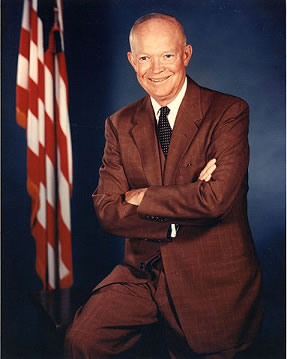 |
David Dwight Eisenhower Born: October 14, 1890
|
|
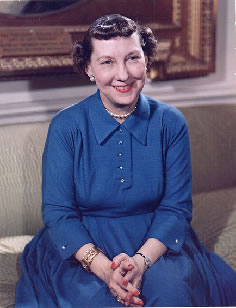 |
|
First lady: Mamie Eisenhower |
|
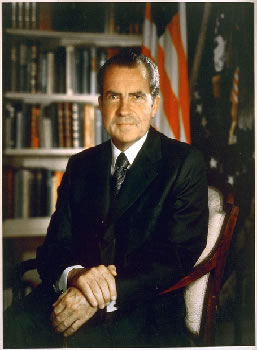 |
|
Vice-president: Richard Milhous Nixon |
|
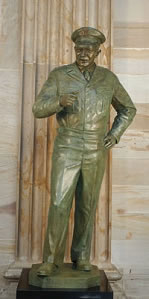 |
|
| Bronze statue of Eisenhower at Capitol rotunda | |
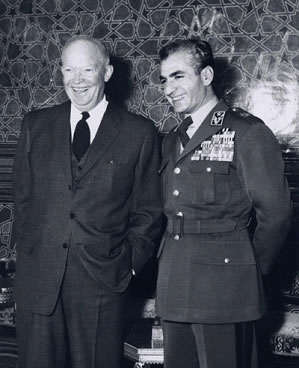 |
|
| Eisenhower with the Iranian Shah Mohammad Reza Pahlavi |